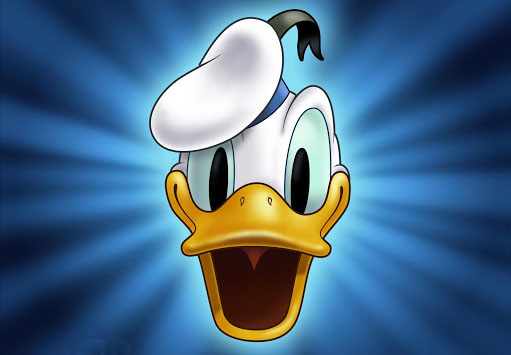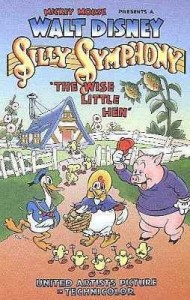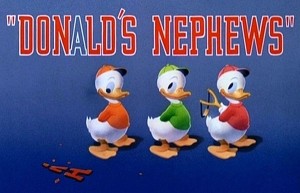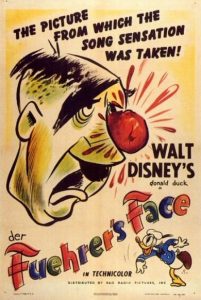
Donald may be a Duck, but he is relatable to everyone. We’ve all had our frustrations and reached our breaking points, but when Donald reaches his, and his hands fly in the air, the sailor’s outfit becomes a blur of blue. There is a torrent of imperceptible squawking, and we can all relate to this reaction to life’s most infuriating moments.
This personality trait has endeared Donald Duck to audiences and earned him the title of one of animation’s most iconic stars, as this year marks the 90th anniversary of his first screen appearance.
 Donald debuted in The Wise Little Hen, Walt Disney’s Silly Symphony (according to Disney A to Z by Dave Smith, it was released on June 9, 1934). In the short, Donald was a supporting player but turned out to be a scene-stealer.
Donald debuted in The Wise Little Hen, Walt Disney’s Silly Symphony (according to Disney A to Z by Dave Smith, it was released on June 9, 1934). In the short, Donald was a supporting player but turned out to be a scene-stealer.
In The Wise Little Hen, directed by Wilfred Jackson, the titular character seeks assistance planting and harvesting her corn. She approaches her neighbors, Peter Pig and Donald Duck. They both pretend to have belly aches to get out of work.
However, when she cooks the corn and bakes delicious cornbread and muffins, she looks for someone to help her eat her corn. She asks Peter and Donald to help, and when they agree, she gives them castor oil to alleviate their “belly aches.” As with many animated characters, Donald’s appearance in The Wise Little Hen differed from what he developed into.
What connected audiences with Donald wasn’t just his appearance or persona as a troublemaker but the unique vocal performance of Disney Legend Clarence “Ducky” Nash.
Two other Disney Legends, animators Frank Thomas and Ollie Johnston, discussed the impact of Nash’s performance in their book, Too Funny For Words: Disney’s Greatest Sight Gags, when they wrote: “…as Walt and the story crew looked at the drawings and listened to the strange vocal sounds coming from Clarence ‘Ducky’ Nash, a new personality emerged. The words could scarcely be recognized, but the emotional content of the acting was unmistakable. It was decided that Donald should recite a well-known poem in his next picture so the audience could follow what was being said, and it was a short step from there to complete disaster when the recitation was interrupted. Thanks to Clarence, this was funnier than it might sound.”

Clarence Nash
With his distinct voice and personality, Donald was such a hit early on that he eclipsed Mickey Mouse in popularity. One of the solutions for this was to have Mickey team up with Donald and Goofy, in such short subjects as Mickey’s Service Station (1935) and Clock Cleaners, (1937), both directed by Ben Sharpsteen, as well as Lonesome Ghosts, directed by Burt Gillett, just to name a few.
As Leonard Maltin noted in his book, Of Mice and Magic: A History of American Animated Cartoons: “These superbly animated shorts featured the characters as a team that approached a given situation, then split up for solo episodes before coming together again at the finale. While the formula began to wear thin toward the end of the 1930s, the above-named shorts presented the Disney machinery working at full steam: wonderful characters and funny, fantastic situations.”
 The shorts mark just some of Donald Duck’s impressive 90-year career milestones. He met his longtime girlfriend, Daisy Duck, in the 1937 short Don Donald (where she was known as Donna Duck), once again directed by Sharpsteen. She became known as Daisy in the popular 1940 short Mr. Duck Steps Out, directed by Jack King.
The shorts mark just some of Donald Duck’s impressive 90-year career milestones. He met his longtime girlfriend, Daisy Duck, in the 1937 short Don Donald (where she was known as Donna Duck), once again directed by Sharpsteen. She became known as Daisy in the popular 1940 short Mr. Duck Steps Out, directed by Jack King.
In 1938, Donald’s sister Dumbella sent him a note that reads: “I’m sending your angel nephews to visit you,” in the short subject, Donald’s Nephews (directed by King). Here audiences were introduced to Huey, Dewey, and Louie, who would go on to star with their Uncle in a number of shorts, including the Halloween favorite, Trick or Treat (1952), directed by Jack Hannah.
 His nephews wouldn’t be the only co-stars to put the fowl Donald into a foul mood. The chipmunks Chip N’ Dale also stirred up Donald’s ire in such films as Chips Ahoy (1956), directed by Jack Kinney, where they take over Donald’s model ship, and the 1949 Christmas short, Toy Tinkers, directed by Hannah.
His nephews wouldn’t be the only co-stars to put the fowl Donald into a foul mood. The chipmunks Chip N’ Dale also stirred up Donald’s ire in such films as Chips Ahoy (1956), directed by Jack Kinney, where they take over Donald’s model ship, and the 1949 Christmas short, Toy Tinkers, directed by Hannah.
Donald also played a significant role in the War effort during the 40s, in shorts such as Fall Out, Fall In (1943), and Commando Duck (1944), both directed by King, and most notably, 1943’s Der Fuehrer’s Face, which featured Donald’s nightmare, where he lives in a caricaturized Nazi Germany. Directed by Jack Kinney, the short won the Oscar for Best Animated Short and gave the world the hit title song when popular bandleader Spike Jones recorded a version of it.
Donald was also featured in Disney’s films Saludos Amigos (1943) and The Three Caballeros (1945). Norm Ferguson was Supervising Director on both films, which were commissioned by the United States Department of State as part of the Good Neighbor Policy with Latin America.
The latter of the two films partnered Donald with the characters Jose Carioca and Panchito in a memorable team-up and a brilliantly animated musical sequence of their title song by Disney Legend Ward Kimball.
In a 1995 interview, Kimball discussed how The Three Caballeros song sequence allowed for “breaking the rather conservative rules of animation. For instance, if a character goes out on the right, he should come back in on the right and I had them going out on the right and coming back in on the left or coming down from the top of the screen!”
Donald’s success went beyond the screen to comic books, thanks to another Disney Legend, writer and artist Carl Barks, who not only helped Disney’s famous Duck segue to comics but created the world of Duckburg, characters like Uncle Scrooge McDuck, Gyro Gearloose, Magica De Spell, and wondrous adventures for them all.
Donald’s popularity has continued, and he has been a character passed down from generations of audiences and artists. From appearances in Mickey’s Christmas Carol (1983), directed by Burny Mattinson, Who Framed Roger Rabbit (1988), directed by Robert Zemeckis, with animation supervised by Richard Williams, and in the “Pomp and Circumstance” sequence, directed by Francis Glebas, in Fantasia 2000.
“The thing about Donald is that he’s that piece of us that tries, against our better will, to do something that he shouldn’t be doing and that’s why he deserves to be ‘smashed,’” said Glebas in a 1999 interview. “That’s what was funny.”
Donald has also been a part of the hugely popular TV series DuckTales (1987) and has made more recent appearances in shows like Mickey Mouse Funhouse. Through it all, his feathers may continue to get ruffled, but his star still shines bright ninety years after his debut.
In his book, the Encyclopedia of Walt Disney’s Animated Characters, author John Grant wrote of Donald Duck: “One can predict with some confidence that he will still be remembered in a century’s time when many of today’s live actors have been forgotten. And why? Well, probably because he is the perfect epitome of so many human characteristics: past or not, he is just right.”


 Michael Lyons is a freelance writer, specializing in film, television, and pop culture. He is the author of the book, Drawn to Greatness: Disney’s Animation Renaissance, which chronicles the amazing growth at the Disney animation studio in the 1990s. In addition to Animation Scoop and Cartoon Research, he has contributed to Remind Magazine, Cinefantastique, Animation World Network and Disney Magazine. He also writes a blog, Screen Saver: A Retro Review of TV Shows and Movies of Yesteryear and his interviews with a number of animation legends have been featured in several volumes of the books, Walt’s People. You can visit Michael’s web site Words From Lyons at:
Michael Lyons is a freelance writer, specializing in film, television, and pop culture. He is the author of the book, Drawn to Greatness: Disney’s Animation Renaissance, which chronicles the amazing growth at the Disney animation studio in the 1990s. In addition to Animation Scoop and Cartoon Research, he has contributed to Remind Magazine, Cinefantastique, Animation World Network and Disney Magazine. He also writes a blog, Screen Saver: A Retro Review of TV Shows and Movies of Yesteryear and his interviews with a number of animation legends have been featured in several volumes of the books, Walt’s People. You can visit Michael’s web site Words From Lyons at: 






















Also, Donald Duck starred in several fairly earnest educational films. During WWII there were theatrical shorts about paying taxes and being thrifty; after the war came shorts on home/work safety and littering. Plus two featurettes, “Donald in Mathmagic Land” and “Donald and the Wheel”. In a way “Saludos Amigos” and “Three Caballeros” are educational films, mixing travelogue and culture with comedy.
“Scrooge McDuck and Money” starred Donald’s uncle and nephews, so is somewhat related.
After Ub Iwerks left Disney to start his own cartoon studio, taking Disney’s music director and many of his best artists with him, Walt Disney seemed determined to prove that “Anything Ub can do, I can do better.” The very first Iwerks cartoon, “Fiddlesticks”, consists largely of an animated violin recital played by a mouse wearing red shorts and white gloves (and accompanied on the piano by nominal star Flip the Frog); while in Disney’s first cartoon made without Iwerks, “Fiddling Around”, a similarly-accoutred Mickey Mouse plays a solo concert on the very same instrument.
The second Iwerks ComiColor cartoon — a series created to rival Disney’s Silly Symphonies — was “The Little Red Hen”, released early in 1934 and based on the same story as Disney’s later “The Wise Little Hen”. The two cartoons are similar in many particulars, for example the narration sung by a male vocal trio. Of note here is that in the Iwerks version, the hen repeatedly asks for help from three barnyard animals: a pig, a duck, and a mouse. “Not I,” says the pig, “I’m much too fat!” “Not I,” says the duck, “my feet are flat!” “Not I,” says the mouse, “go ask the cat!” “Ah, I’ll do it all myself!” responds the hen.
So it’s interesting that Disney also cast a pig and a duck, in the same order, as the lazy and unhelpful ones in his version of the story. As for Disney’s mouse, well, he was already starring in his own series of cartoons and therefore unavailable at this time.
There’s no question that the Disney cartoon is a great improvement over the Iwerks one. But it’s worth considering that, just as Ub Iwerks is now regarded as the co-creator of Mickey Mouse, he may also have had some influence, if only as an object lesson, upon the creation of Donald Duck as well.
What stands out in my mind about “The Wise Little Hen” is not Donald’s debut performance, but the hen’s mouthwatering corn feast; it makes me hungry every time I see it. It also amuses me that the hen’s chicks are all wearing little white shoes! I assume that was done to spare the animators the trouble of having to draw their toes over and over again.
I thought Dick Lundy was mainly responsible for developing Donald.
Lundy first animated Donald Duck in his second cartoon, “Orphan’s Benefit”, and was very influential in developing the duck’s personality. But in his first cartoon, Donald was designed by Albert Hurter and animated by Art Babbitt and Dick Huemer.
WOW! It seems like just yesterday I bought a book on Donald’s 50th Anniversary!
Happy 90th anniversary to Donald Duck! 😀
Donald Duck and The Wise Little Hen will be public domain on January 1, 2030!
So Disney didn’t release a 90th anniversary Donald Duck Shorts Bluray collection? What a missed opportunity
I think they might be saving that for his centennial. (I could be wrong.)